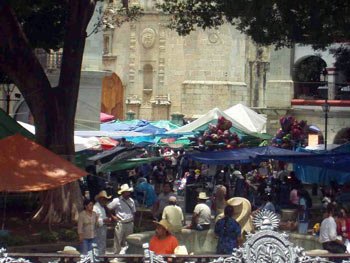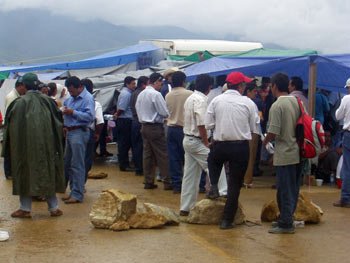


Oaxaca Near Meltdown Over Teacher Strike
More than Just an Educators’ Pay Dispute, the Conflict Is a Sign of Governor Ruiz’s Inability to Rule a State Fed Up with Repression and Corruption
By Nancy Davies
The Other Journalism with the Other Campaign in Oaxaca
June 7, 2006
It’s unprecedented and nobody knows what will happen, but nobody is backing down.
Tens of thousands of striking teachers occupy the center of Oaxaca city, sprawled out under camp tents, on top of cardboard cartons, on stairs and walls and benches. The plantón — the occupying camp — has now been going on for fifteen days. It covers 56 blocks, preventing all traffic and access to the heart of the central square, or zócalo.
 Oaxaca teachers occupy the city’s central square Photo: D.R. 2006 George Salzman |
Reportedly, outside the city, about twenty-five kilometers away, 1,500 federal riot cops, requested by Ruiz and sent by President Fox, await orders.
I asked Noé Sotomayor Hernandez, the supervisor of 18 secondary technical schools in the southern coast region, what he thought of that threat. “We sent people out to look, and they didn’t see anything like that. It’s pure intimidation, there’s no proof of how many federal police are there. But,” he smiled, “it’s a threat we took on and we face it.”
This is the stand-off in an escalating battle between Governor Ruiz and Section XXII of the National Education Workers’ Union (SNTE in its Spanish initials) headed by secretary general Enrique Rueda Pacheco. The conflict is more than an education workers’ strike; it is a sign of Ruiz’s inability to govern in a climate fed up with repression and corruption.
It’s true that in past years the teachers’ strike was something like the swallows’ return to Capistrano — an annual event. For twenty-seven years the teachers union has been trying to wrest sufficient funds from Oaxaca governors to aid poverty-ridden towns where class-rooms of cardboard and laminated plastic roofs, without sanitary facilities, are common.
But this strike feels different; the level of name-calling and recriminations reaches higher than ever before. The union has called for Ruiz to resign. Ruiz called for federal police. The union publicly and firmly asserted that Ruiz is a thief, a bastard, and several times over an assassin. Ruiz solicited a condemnation of the union by the state legislature. On June 2 the union staged a mega-march of teachers and supporters: 100,000 people if you ask the teachers, 80,000 if you read the newspapers, and 50,000 if you consult the police. It stretched 5 kilometers, with many of the marchers’ family members alongside students and their families.
The next mega-march is scheduled for Wednesday June 7, and will likely be bigger.
Other groups are stepping forward in support. The Indian Organizations for Human Rights in Oaxaca (OIDHO) expressly state that their participation is as adherents of the Other Campaign.
The Oaxaca newspaper Las Noticias reports that the board of the National Coordinator of Education Workers is meeting in Oaxaca, and other social organizations like the macheteros of Atenco, machetes in hand, plan to join the march of the Oaxaca teachers to aid their fellow and sister Other Campaign adherents.
 Blockading highway construction near the city Photo: D.R. 2006 George Salzman |
Added to that, more than 800 communities, of all Oaxaca ethnicities, have spoken out in support, repudiating violence, assassination, the holding of political prisoners, repression of the press and the heavy hand of political bosses (“caciques”). They placed a quarter page ad in the daily paper Las Noticias on June 6.
Meanwhile, the daily newspaper Imparcial also carried paid advertisements signed by municipal presidents demanding that the teachers go back to work.
On June 5, the zócalo was, as it has been, foot-accessible only. It’s covered with colorful tents and plastic drapes; more vendors daily add goods like commercial clothing and underwear to the fair-like scene of food, balloons and artisan products. One older woman accompanied by her young son (clearly he’s not in school!) kept prompting him to try his English — hello, how are you, where are you from, etc. Asked if she was afraid of Ruiz’ threats, she replied, “Not at all, we’ve been doing this for years.” Across from us a little girl was perched on the shoeshine stand, getting her boots shined in the Oaxaca tradition.
Ruiz has now withdrawn his offer of a small salary increase. The teachers are demanding equal pay throughout a state which is divided into three salary zones based on the supposed cost of living. The teachers are also demanding an increase for students receiving grants which now amount to 450 pesos per month. That’s $40 U.S. dollars. They’re demanding decent schools, classroom supplies, and government funding for uniforms which are out of reach of so many poor families that the children stay home.
The strikers are well organized, with rotating shifts for blocking and picketing in all the areas now under their control. Cell phones as well as their Radio Plantón broadcasts are used for communications. The radio station has moved to a safer location. A radio in the center of the zócalo on a folding table broadcasts all night long. Furthermore, the zócalo and the streets around it are such a maze of ropes and flapping plastic that unless the police came in tanks they’d enter very slowly, and the strikers would have time to defend themselves or flee.
Out three blocks on the western side of the zócalo lies a security perimeter. No sign of the reported sticks or weapons, just teachers wearing security badges sitting on the curb with cell phones. Westward, Plaza de la Danza, recently renovated by the governor, is now occupied completely by teachers. This is the plaza that gives (would give) access to the municipal offices. Lots of fruit, Italian ices (raspas), popsicles, straw hats and Chinese parasols are displayed on sale. The sky looks like a thunderstorm in a couple of hours — this is the rainy season. Teachers fill the grandstand beneath plastic tarps, embroidering and knitting, or reading the daily papers. Peaceful and unconcerned.
They may be right. It’s another area tactically bad for staging an attack.
The Plaza wall borders Morelos Street, a main street of Oaxaca heading west, which is blocked. Truly the city is damn near impassable, most of the traffic is being re-routed into different jams. Traffic cops out in force keep the cars going, although not necessarily where they want to go.
This is no longer, if ever it was, a simple labor strike. The teachers, in defiance of the governor’s demands that they return to classes, have broadened their actions to include an invasion of the state legislature which lasted several hours, two major encampments, blockage of works in progress, and the blocking of the airport road.
Ruiz has spent money for unwanted renovations generally thought of as opportunities to skim off money for the PRI and for himself. There’re no funds to spend on education. The teachers condemn the expenditure of more than two billion pesos (US$175 million) spent by Ruiz in remodeling the zócalo, Llano Park, Plaza de la Danza, the Fountain of Seven Regions, Cinco de Mayo Street in the tourist area, and the Guelaguetza stadium, while allegedly siphoning off 90,000,000 pesos (US$8 million) for the PRI campaign. These numbers are published in both Oaxaca daily papers — important because there has been no accounting of government spending up until now.
Furthermore, many citizens are enraged at the blatant remodeling of places named by the UN as cultural patrimonies, with no citizen input, and the inevitable destruction of well-loved trees and public areas.
One such area is the Guelaguetza stadium, the site for a cherished local events each July. According to Sotomayor, on duty blocking the construction, a year would have been a proper time frame to complete the work, but Ruiz has never spent public funds on a reasonable time frame — the zocalo was not ready for the Christmas fiesta Night of the Radishes — despite his unending complaints about losing tourist dollars. The presidential election is in July, and now is when he needs money for advertising on television and radio. As part of their campaign, the strikers have occupied the Guelaguetza work site from 9:00 AM to 4:00 PM. Up on the construction for widening the road, teachers’ plastic sheets reach to the second level of the stadium. Three kilometers of road are torn up. Sotomayor says plainly, if there’s no money for teachers and the poor, there’s no money for widening the road.
Strikers closed the airport road. Tourism is disrupted, as it has been since the attack on Atenco, by foreigners advising the Mexican authorities that they are being watched. Movements have learned how to internationalize their struggle and use that to their advantage.
The relentless confrontation tactics of the union go way beyond seeking negotiations. They demand a complete overhaul of state government. The struggle encompasses all the political ill will and citizen ire that has built up in Oaxaca for decades, around basic issues such as government failure to protect towns against flooding, the murderous control by caciques, lack of health services to deal with the epidemic of cervical cancer among women, the brutalization of women accepted by the culture of machismo, the cooperation with narco-traffickers and gangsters.
Essentially, this strike is a combination of social forces, many of which were brought together in February by the Other Campaign, now also attracting the electoral political force that is the PRD, in a massive concentration of protest.
Unless Ruiz has forgotten the lessons of the Zapatista Netwar, he clearly puts other priorities ahead of tourist income, that is to say, he wants cash NOW, for Madrazo and the PRI, literally a last toss of the coin.
But whatever goes down next in Oaxaca will not be — as in the past — in silence. The eyes of the world are upon it. What is happening in Oaxaca previews where the Other Campaign will go with Civil Society after election day, no matter who wins the presidency.
Click here for more Narco News coverage of Mexico
- The Fund for Authentic Journalism
For more Narco News, click here.




